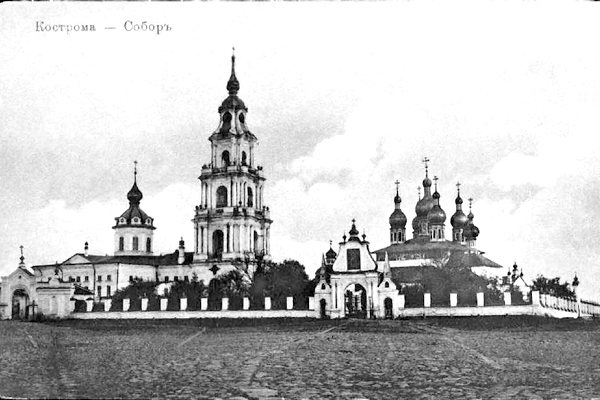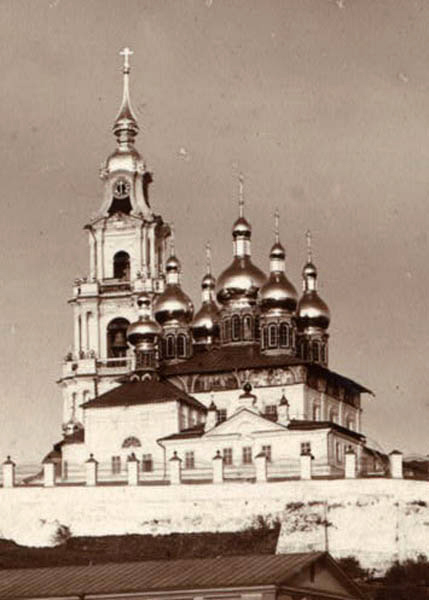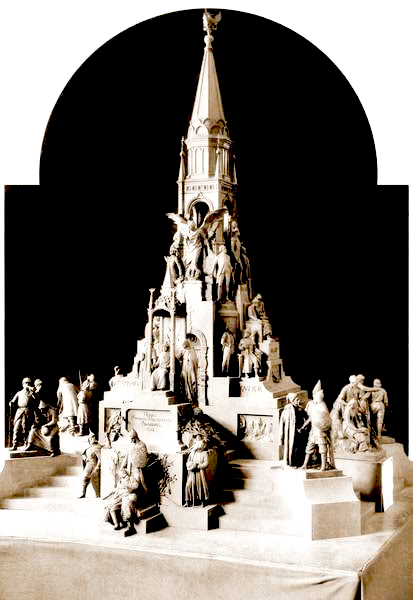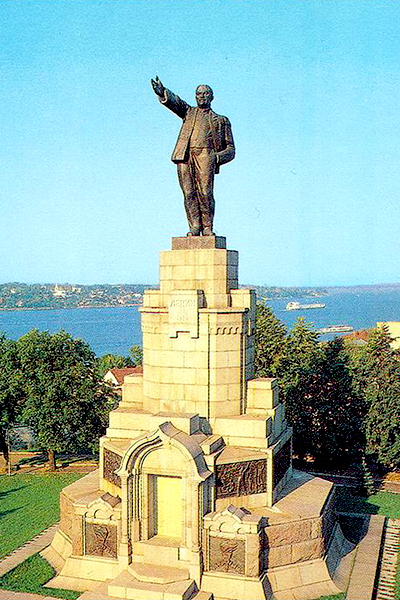
The Mystery of the Kostromsky Phoenix
/ Главная / Russkiy Mir Foundation / Publications / The Mystery of the Kostromsky PhoenixThe Mystery of the Kostromsky Phoenix
The Kostromsky Kremlin, blown up in 1934, was once one of Russia’s finest architectural monuments. Thankfully, the kremlin is being rebuilt; work on the restoration of this architectural masterpiece is planned to be completed by 2020. However, the reasons for its barbaric destruction remain a mystery to historians. In particular, the documents connected with the decision taken to destroy the kremlin remain locked up under the state secrets act. Why?

View of the kremlin in 1934
“The missing kremlin is like an open wound”, Kostroma Region Governor Viktor Shershunov told me in an interview several years ago. “But where can we take the money? Our region, in contrast to, say, the neighbouring Yaroslavl Region, is very poor”.
Where state and federal budgets fail to help, local people reach into their pockets. The Yaroslavl Region businessman Viktor Tyryshkin is well known in both his native region and in Kostroma. He personally financed the reconstruction of the beautiful Rybinsk Cathedral, and rebuilt from the ground up, in strict adherence to the original architectural plans, the church which stands on the meeting point of the Volga and the Kotorosla rivers in Yaroslavl.
“The Kostromsky Kremlin represented one of the greatest achievements of Orthodox architecture; the ensemble, with the cathedral, bell tower and kremlin gates, was unique, and of extraordinary beauty”, says Viktor Tyryshkin of the Kostromsky Detinets, as it is known locally [note on translation: Detinets is an old Russian word similar in meaning to kremlin]. “We must restore the kremlin to its original form, as designed and executed by the architect Stepan Vorotilov.
The bell tower of master Stepan
Archaeological research places the emergence of the town of Kostroma in the mid-12th century, in a location on the mouth of the Sula River slightly higher than the town’s current position. The wooden fortifications of the detinets, the future kremlin, as was often the case frequently burnt down, so a decision was taken to move the fortress to its current location. Besides the fortifications themselves, a number of churches were built as part of the architectural ensemble, beginning with the five-domed Assumption Cathedral, most probably built in the 16th century. Later came the Epiphany Cathedral, built with one dome in the neo-classical 18th century style favoured by Catherine II. In the same period the kremlin’s true masterpiece appeared: the magnificent 64-metre, four-tiered bell tower.

The Assumption Cathedral and bell tower of the Kostromsky Kremlin
Both these 18th-century monuments were designed and built by the Russian architect Stepan Andreevich Vorotilov, a man of difficult character but phenomenal talent who, as is often the case in Russia, died at a tragically early age. The famous pre-revolutionary historian of Russian antiquity Georgy Lukomsky once said that the bell tower reminded him of an Indian pagoda. It was said that the neighbouring kremlin of Yaroslavl was visible from the top of the tower in fine weather.
As Lukomsky wrote in one of his books: “Approaching Kostroma on the Volga, passengers crowd the deck of the steamer to wonder at the distant Assumption Cathedral, standing on its hill and surrounded by a group of white, golden-topped buildings. The cathedral, laid out with the nave facing the north, stands out from the rest of the architectural ensemble, not only as a result of this unusual plan but also thanks to the magnificent shine of its golden domes and its unusual silhouette, formed by the elongation of the onion domes as they stand on stretched-out necks to produce an effect of even greater elongation, giving the appearance of an almost conical form. The domes are so wondrously golden that on a particularly sunny day they are almost impossible to apprehend, so bright the line reflects onto the eyes. On days such as these they cast their golden light over everything around, surrounding the cathedral with a halo of heavenly light”.
While the cathedrals took centre place, of almost equal importance were the other structures, including the faux-gothic gates, the royal reception room, and the two servants’ quarters. The raising of a grand monument to the Romanov dynasty was begun on a plot between the cathedrals in preparation for the 300th anniversary of the royal house in 1913. According to Estonian sculptor Amand Adamson’s design, the huge pedestal of the monument was to be decorated with 20 life-size sculptures of key historical figures. By 1916, two stood in their allotted places; the remaining figures were waiting to be mounted, but before they could be put up, the country’s history took a dramatic change of course.
“With Lenin in their heads and sledgehammers in their hands”
In a ceremony held to bless the laying of the first stone of the new Assumption Cathedral, Patriarch of Moscow and All Rus’ Kirill said: “It is difficult to imagine what exactly could motivate anyone to destroy a place as beautiful as this and to inflict such a deep wound on this city, on its history and the spiritual wellbeing of its people”.

Monument to the 300th anniversary of the Romanov dynasty
I disagree; the explanation is, in fact, rather simple: the Bolsheviks had particular scores to settle with the rich upper-Volga trading towns of Yaroslavl and Kostroma. While the former was never forgiven for its cardinal sin, the July 1918 Yaroslavl uprising, Kostroma, as the alma mater of the Romanv dynasty, was considered an ever greater threat. Thus while Yaroslavl, with its multitude of magnificent surviving churches, is unofficially known as the “Russian Florence”, Kostroma, which, as numerous memoirs attest, was once considered no less wondrous, today draws far fewer tourists.
It is not difficult to understand why – even before the fateful year of 1934 when the city’s kremlin was destroyed, the Bolsheviks thirst for destruction laid waste to over 30 beautiful churches of the unfortunate town. At the same time understanding the logic behind such barbarism is no easy task; why, for example, was one of the holiest sites of the Romanov dynasty, the Ipatyevsky Monastery, spared? At the monastery only one of the smaller churches was destroyed, the Church of the Nativity of the Blessed Virgin, rebuilt in 2013-2015. As for the kremlin and the town’s churches themselves, they were eliminated with a lust that even in those schizophrenic times was often commented on with horror.
The exact circumstances surrounding the destruction of the Kostromsky Kremlin remain a mystery to this day. All the documents connected with the decision and its execution are still kept as state secrets even today. According to local rumour, the tragic fate of the historical monument is bound up with the name of that “great son of the Bulgarian nation” Georgy Dimitrov. Dimitrov, returning to the Soviet Union in late 1933 after his acquittal at the infamous Leipzig trial, was quickly installed as a deputy of the Supreme Soviet of the Soviet Union, with a constituency centred on, alas, Kostroma. His attitude towards historical preservation is easy enough to understand from a stenographic record, kept under public access at the the Russian State Library, of his participation at a commission of the time that was charged with planning the “socialist reconstruction” of Moscow. Without blinking an eye, comrade Dimitrov proposed flattening the entire region of Kitay Gorod [translator’s note: a large region in central Moscow featuring well-preserved historic churches and 19th-century aristocratic town houses], just so that the socialist masses would have space enough to stand in line while queueing to Lenin’s Mausoleum on Red Square. What sanctity could the Kostromsky Kremlin to a man accustomed to such logic? It was men such as these that were immortalised in the well-known phrase: “with Lenin in their heads and sledgehammers in their hands”.
Saving face
The Kostromsky Kremlin was almost entirely wiped off the face of the earth in the summer of 1934. In a fine testament to Vorotilov’s skill as an architect, the beautiful bell tower resisted the barbarians’ explosions one after the other, but eventually succumbed to its tragic fate. The figures of the Romanov jubilee monument were sent to be recast, presumably in the form of the new Bolshevik saints. Only two of the secular buildings remained, the Royal Reception Hall, renamed the Ostrovsky Hall, and the pedestal of the unfinished monument, which in 1928 was capped by a statue of that same Vladimir Lenin that gave the order which sent the Romanovs to the firing squad. One is forced to remember the unfortunate choice of words of that evil genius, who once reminded Bolshevik vandals that: “When destroying monuments, preserve the pedestals. They could come in handy”. During the Soviet period Lenin was frequently installed in others’ places: in Vladimir, Samara, Rybinsk and many other cities he displaced the Tsar-Liberator Alexander II.

A monument to Lenin stands on the site of the original architectural ensemble
Having destroyed the kremlin, the Bolsheviks inflicted a brutal scar on Kostroma’s once beautiful face. At the same time they deprived the city of that crucial element of all medieval Russian towns – its bells and bell tower. In the late 1980s a group of young Muscovite and Kostromsky historians developed a plan to restore the kremlin to its original glory, based on preserved sketches and photographs.
And, at least from the historical perspective, in the mere blink of an eye the kremlin will once again grace the city. And as for solving the historical puzzle of who ordered its destruction, and why, who knows how many years or centuries we will have to wait.
New publications

 Mikhail Kalatozov, a director who transformed the world of cinematography in many ways, was born 120 years ago. He was a Soviet film official and a propagandist. Above all, he was capable of producing movies that struck viewers with their power and poetic language.
Mikhail Kalatozov, a director who transformed the world of cinematography in many ways, was born 120 years ago. He was a Soviet film official and a propagandist. Above all, he was capable of producing movies that struck viewers with their power and poetic language.  Ukrainian authorities have launched a persecution campaign against the canonical Ukrainian Orthodox Church (UOC), the biggest one in the country's modern history. Over the past year, state sanctions were imposed on clergy representatives, searches were conducted in churches, clergymen were arrested, criminal cases were initiated, the activity of the UOC was banned in various regions of the country, and monasteries and churches were seized.
Ukrainian authorities have launched a persecution campaign against the canonical Ukrainian Orthodox Church (UOC), the biggest one in the country's modern history. Over the past year, state sanctions were imposed on clergy representatives, searches were conducted in churches, clergymen were arrested, criminal cases were initiated, the activity of the UOC was banned in various regions of the country, and monasteries and churches were seized.  When Nektary Kotlyaroff, a fourth-generation Russian Australian and founder of the Russian Orthodox Choir in Sydney, first visited Russia, the first person he spoke to was a cab driver at the airport. Having heard that Nektariy's ancestors left Russia more than 100 years ago, the driver was astonished, "How come you haven't forgotten the Russian language?" Nektary Kotlyaroff repeated his answer in an interview with the Russkiy Mir. His affinity to the Orthodox Church (many of his ancestors and relatives were priests) and the traditions of a large Russian family brought from Russia helped him to preserve the Russian language.
When Nektary Kotlyaroff, a fourth-generation Russian Australian and founder of the Russian Orthodox Choir in Sydney, first visited Russia, the first person he spoke to was a cab driver at the airport. Having heard that Nektariy's ancestors left Russia more than 100 years ago, the driver was astonished, "How come you haven't forgotten the Russian language?" Nektary Kotlyaroff repeated his answer in an interview with the Russkiy Mir. His affinity to the Orthodox Church (many of his ancestors and relatives were priests) and the traditions of a large Russian family brought from Russia helped him to preserve the Russian language.

 The leaders of the Friends of the Great Russia cultural association (Amici Della Grande Russia) in Italy believe that the Western policy of abolishing Russian culture in Europe has finally failed. Furthermore, it was doomed to failure from the beginning.
The leaders of the Friends of the Great Russia cultural association (Amici Della Grande Russia) in Italy believe that the Western policy of abolishing Russian culture in Europe has finally failed. Furthermore, it was doomed to failure from the beginning.  Name of Vladimir Nemirovich-Danchenko is inscribed in the history of Russian theater along with Konstantin Stanislavski, the other founding father of the Moscow Art Theater. Nevertheless, Mr. Nemirovich-Danchenko was a renowned writer, playwright, and theater teacher even before their famous meeting in the Slavic Bazaar restaurant. Furthermore, it was Mr. Nemirovich-Danchenko who came up with the idea of establishing a new "people's" theater believing that the theater could become a "department of public education."
Name of Vladimir Nemirovich-Danchenko is inscribed in the history of Russian theater along with Konstantin Stanislavski, the other founding father of the Moscow Art Theater. Nevertheless, Mr. Nemirovich-Danchenko was a renowned writer, playwright, and theater teacher even before their famous meeting in the Slavic Bazaar restaurant. Furthermore, it was Mr. Nemirovich-Danchenko who came up with the idea of establishing a new "people's" theater believing that the theater could become a "department of public education."  "Russia is a thing of which the intellect cannot conceive..." by Fyodor Tyutchev are famous among Russians at least. December marks the 220th anniversary of the poet's birth. Yet, he never considered poetry to be his life's mission and was preoccupied with matters of a global scale. Mr.Tyutchev fought his war focusing on relations between Russia and the West, the origins of mutual misunderstanding, and the origins of Russophobia. When you read his works today, it feels as though he saw things coming in a crystal ball...
"Russia is a thing of which the intellect cannot conceive..." by Fyodor Tyutchev are famous among Russians at least. December marks the 220th anniversary of the poet's birth. Yet, he never considered poetry to be his life's mission and was preoccupied with matters of a global scale. Mr.Tyutchev fought his war focusing on relations between Russia and the West, the origins of mutual misunderstanding, and the origins of Russophobia. When you read his works today, it feels as though he saw things coming in a crystal ball...